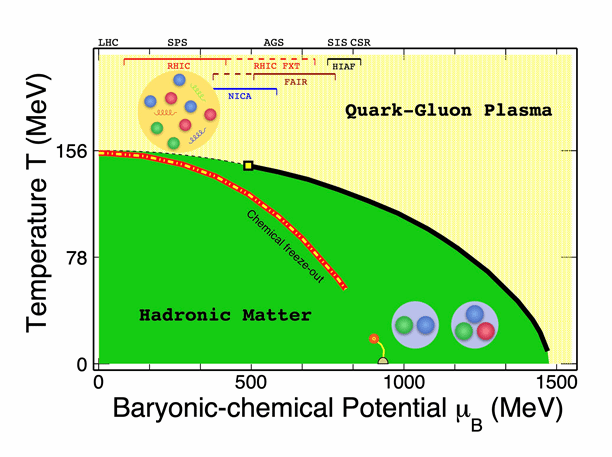Recently, the research team led by Professor Shi Susu published a groundbreaking study titled "Emergence of Constituent Quark Number Scaling in Heavy-Ion Collisions at RHIC" in Physical Review Letters (Phys. Rev. Lett.), with the team serving as primary contributing authors. The study utilized data from the Beam Energy Scan (BES) program at the Relativistic Heavy Ion Collider (RHIC) at Brookhaven National Laboratory, analyzing gold-gold collision data. For the first time, the team observed that the constituent quark scaling (CQS) of collective flow breaks down completely at collision energies below 3.2 GeV but gradually restores in the 3.2–4.5 GeV range. This discovery provides new experimental evidence for the phase transition from hadronic matter to quark matter. The paper was submitted by the team's doctoral student Liu Like, with key contributions also from fellow doctoral students Liu Zuowen, Wang Guoping, and Wu Xing.

Illustration: A schematic phase diagram of strongly interacting substances, showing the hadron parton transition process in heavy ion collisions, where the vertical axis represents temperature and the horizontal axis represents baryon chemical potential.
The thermalized quark matter formed in high-energy heavy-ion collisions is known as the "quark-gluon plasma (QGP)," a state of matter that existed in the early universe shortly after the Big Bang. The formation mechanism and critical conditions of QGP have long been unresolved mysteries. The constituent quark scaling of hadronic collective flow serves as crucial experimental evidence for QGP formation. In 2004, the STAR research team at Central China Normal University (CCNU) first observed this scaling in the collective flow of neutral strange particles at 200 GeV, providing early evidence for QGP. Since 2006, Shi Susu has dedicated her research to studying the collective flow of light-flavor and (multi-)strange particles. Leveraging STAR's high-statistics data, her team achieved precision measurements of multi-strange particles (particularly Ω baryons) and neutral/strange D-meson collective flow. Their findings confirmed that collective flow from light to heavy-flavor particles adheres to constituent quark scaling at 200 GeV, indicating partonic-level collective behavior and the formation of thermalized quark matter—the strongest evidence for QGP. These results were published in Phys. Rev. Lett. 116, 062301 (2016); Phys. Rev. Lett. 118, 212301 (2017); and Phys. Rev. Lett. 127, 212301 (2021).
Following the discovery of QGP, investigating its properties and identifying potential phase transition signals became pivotal in high-energy nuclear physics, prompting RHIC's Beam Energy Scan program. Using data from 2010–2011 (7.7–62.4 GeV), the team systematically studied collective flow across light-flavor to strange particles, revealing that constituent quark scaling persists even at 7.7 GeV (Phys. Rev. Lett. 110, 142301 (2013)). In 2022, their analysis of Phase-II BES data showed the disappearance of this scaling at 3 GeV, documented in Phys. Lett. B 827, 137003 (2022).
The latest study focuses on the phase structure of strongly interacting nuclear matter. By analyzing 2019–2021 Phase-II BES data, the team observed the breakdown and subsequent restoration of constituent quark scaling in the 3.2–4.5 GeV range, marking the first clear identification of the scaling's recovery threshold. Combined with earlier 200 GeV findings, this work completes the evolutionary picture of collective motion in nuclear matter from 200 GeV down to 3 GeV, offering key evidence for the hadron-to-quark matter phase transition.
This research was supported by the National Key R&D Program of China (2022YFA1604900) and the National Natural Science Foundation of China (12175084).
Phys. Rev. Lett. link:
https://journals.aps.org/prl/abstract/10.1103/2qhx-cp79
Preprint link:
https://arxiv.org/abs/2504.02531
END
华大物院党委融媒体中心
华大物院团委宣传中心
通讯员|刘利珂
责 编|李青怡
审 校|秦广友 赵蕴杰